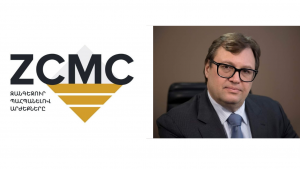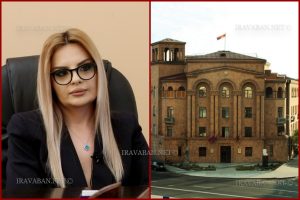The Judicial and Legal Reform Strategy 2019-2023 envisages a number of changes in the field of bankruptcy, including amendments to the Law on Bankruptcy. It is also planned to review the requirements for the Bankruptcy Administrators and their appointment procedure.
Iravaban.net talked about the topic to Bankruptcy Administrator Vahram Apresyan.
– Mr. Apresyan, the strategy states that it is necessary to develop and implement professional training programs for Administrators and to organize the training of candidates before passing the qualification. To what extent is this necessary, will it increase the professional skills of Administrators?
-Since 2002, when Bankruptcy Administrators were licensed, such courses were compulsorily organized by the Ministry of Justice before passing the licensing examination.
licensing examination.
Later, before passing the qualification, the courses were conducted by the Collegium of Business-Managers on Bankruptcy a Self-Regulatory Organization. Starting from 2020, it was stipulated by law that a person who has passed the relevant training in accordance with the procedure established by the RA Minister of Justice N 106-N of 12 March, 2020, can be qualified as an Administrator. In other words, this is not a matter of necessity, but a clear requirement of the law. As for the improvement of the professional skills of the administrator, I think that such training is really necessary, as it gives the candidate the first idea about the bankruptcy proceedings, the actions and functions performed within it. By another order of the RA Minister of Justice of 12 March, 2020 N 104-N, also defined by the legislation, Mandatory annual trainings for qualified persons to ensure the continuous professional development of administrators. I myself have participated in organized training courses and I think that they have a very positive result both for improving the professional skills of administrators and for completing a certain gap of knowledge. At the same time, I consider it necessary to mention that every administrator should strive to raise his professional skills to a high level. If there is no such aspiration, even a mandatory course will not change the quality of the given administrator.
– Today the remuneration of administrators is very different due to the number of cases. To solve this problem, it is also proposed to review the system of appointment of bankruptcy administrators and introduce a new software for the selection of administrators , which should take into account a number of factors in selecting an administrator, such as for example, the complexity of the work, the professional skills and the professional area. Do you think the introduction of such software will contribute to a right, perhaps fairer distribution of bankruptcy cases among administrators?
– This is the most vulnerable problem of all times. Previously, before the 2006 Bankruptcy Law was passed, the administrator was appointed at the discretion of the judge handling the case. Since 2006, the selection of a manager has been done through a computer program on the website of the self-regulatory organization of administrators. At that time, each administrator decided for himself whether to participate in the selection of the bankruptcy administrators or not. Now the selection of the administrators is also carried out by the RA Ministry of Justice through a computer program, but with completely different criteria. A list of administrators with the least number of cases participating in the given draw is defined and they cannot refuse to participate in the election and the administrator of the case is chosen at the principle of the random choice. All the mentioned election forms have always been criticized by both the administrators and the creditors. The current draw has also caused dissatisfaction among some administrators for various reasons: some do not participate in the draw for new cases due to the number of old cases, some complain that they have fewer cases while others have more cases, some do not want to participate in the draw at all, but no option to refuse is provided.
In my subjective opinion, there is still no really fair option to distribute cases. As for the new software, which should take into account the complexity of the case, professional skills and other criteria when selecting an administrator, I think it is impossible to implement it objectively because it is impossible to predict or understand any bankruptcy case. Whether it is a difficult job or not, the administrator will be paid or will receive compensation in the amount of the minimum wage, it is impossible to predict the volume of claims, their security and many other circumstances. Therefore, it is really not possible to determine the “value” of the case from the beginning.
It is also not possible to fairly assess the professional skills of administrator because there are no objective criteria that can be applied to all administrators. No one can claim that if the given administrator has worked in this case like this, then he is a skilled administrator, in another case other working circumstances arise, in the presence of which it is not known how the same administrator will work. There is an opinion that a large role in the evaluation of the work will be given to the number of rehabilitation programs in the cases conducted by the given administrator, which is also not a fair principle, as it is impossible to force the debtor to submit a rehabilitation program if he has no funds or income. In addition, a significant part of bankruptcy proceedings is the cases in which the applicant himself has mediated the appointment of a bankruptcy administrator. That is, such cases are not brought to draw. The main claimants in the mentioned cases are the commercial banks of the Republic of Armenia, which, based on the experience gained during their years, already have preferred administrators, who are always offered as an administrator in the bankruptcy proceedings initiated by them. But all the same, I do not think that those administrators can be considered more skilled than some later qualified ones. This, in fact, is a subjective opinion of the banks.
As a result, during the whole activity of the administrator, various subjective assessments are formed, to which it is impossible to give an objective assessment.
– The strategy proposes to make changes in the Constitutional Law “Judicial Code of the Republic of Armenia”, increasing the number of judges of the bankruptcy court. In your opinion, will this contribute to the reduction of the examination time of the cases? How often are court hearings with your participation scheduled?
– In the last 2-3 years, the RA Bankruptcy Court has been overburdened with both bankruptcy proceedings and civil cases related to bankruptcy proceedings, the proceedings of which it did not carry out before. Yes, I think that the number of bankruptcy judges should be increased; in addition, the previously existing territorial principle should be defined. In my opinion, it is necessary, because according to the current law, the bankruptcy proceedings of a resident of Syunik region or a company operating in that region can be electronically signed to a judge of the Stepanavan residence of the RA Bankruptcy Court. Taking into account that if the debtor has applied to be declared bankrupt, consequently his financial situation is difficult, then it becomes unclear by what means he has to reach Stepanavan to defend his rights by law and finally why?
Of course, with the increase of the number of judges of the RA Bankruptcy Court, the terms of examination of cases will be reduced to some extent.
– Mr. Apresyan, the strategy states that the introduction of an electronic bankruptcy system and the implementation of electronic document circulation will also have a positive impact on increasing the efficiency of the bankruptcy court. What possible problems or difficulties can you mentioned in the practice of this settlement?
– If I am not mistaken, the e-request.am website was launched in 2020, through which it became possible to carry out almost all inquiries, applications and other possible document circulation. This significantly reduced the time required for administrators to work. I should also mention that Article 29, Clause 9 of the Law on Bankruptcy, which has been in force since April 2020, stipulates that the bankruptcy administrator has the right to send notifications also through electronic communication within the scope of his powers defined by law.
I should mention that the notifications sent through the postal service often reached the addressee late, as well as sometimes they did not arrive, which caused serious problems in some functions: notification of the creditors’ meeting, notification of the preliminary list of creditors’ claims, notification of the distribution plan, etc. Currently, the court relies on all notifications sent in the form of official e-mails, and even the court practices notifications via e-mail. Certainly, the introduction of an electronic bankruptcy system and the implementation of electronic document circulation will have a great positive impact on the implementation of bankruptcy proceedings, both in terms of quality and time. As for the difficulties, there are still areas, where the submission of documents in paper form is still mandatory, for example: liquidation of a legal entity in the state register of legal entities of the Republic of Armenia, so the existence of a paper copy of the document will still be maintained. Another problem may be the possible falsification of electronically submitted documents. Taking into account the current software possibilities, it is assumed that a document with a forged signature or another type of forgery may be submitted.
– Within this framework, it is also envisaged to develop a draft Bankruptcy Code, which stipulates that, for example, it is necessary to reduce the terms of bankruptcy proceedings. How do you imagine this? In practice, how much is it possible to reduce that period and what are the ways to reduce the period and the expected result to achieve?
– For quite a long time, everyone has been talking about reducing the term of bankruptcy proceedings, but in reality no practical solution has been given. There was still an article in the oldest editions of the Law on Bankruptcy, which had the same content as Article 89 of the current law, according to which at any stage of bankruptcy proceedings, the case can be terminated by the administrator or debtor if the creditors’ claims are met, but taking into account that the creditors’ claims are satisfied only in accordance with the distribution plan drawn up by the administration, submitted to the court and not challenged within the prescribed period; then any so-called stage becomes a stage about 60-90 days after being declared bankrupt. No legal mechanism has been developed to fulfill the claims in the bankruptcy proceedings until the list of creditors’ claims is approved. It is true that this comes from the tendency to protect the interests of all possible claimants, but there are many cases in which the only claimant is the State Revenue Committee, which applies to a bankruptcy court as required by law. However, the debtor legal entity is an operating institution that faces a number of serious legislative obstacles in the event of a bankruptcy application such as: participation in tenders, obtaining licenses, extension, etc.
Article 105 Part 1 of the Law on Bankruptcy also stipulates that: At any stage of the bankruptcy proceeding upon submission by the Administrator or a creditor and with the consent of the board, the judge – without convening a court sitting – shall render a judgment on closure of the bankruptcy case, where:
- the debtor does not have any property or confiscation of the debtor’s property may not be applied in the manner prescribed by the legislation of the Republic of Armenia;
- it is not possible to find the property of the debtor;
- the property of the debtor is of such small value, that further implementation of bankruptcy procedures is not reasonable;
- expenses to be incurred for finding the property or collecting assets of the debtor do not to justify the further implementation of bankruptcy procedures.
However, what is said at any stage implies the decision to approve the final list of creditors’ claims and to hold the first meeting of creditors in the case of individuals, and in the case of legal entities and sole proprietors to decide on liquidation or termination proceedings and publish that decision on azdarar.am. In this case it lasts about 100-130 days. In addition, it is not defined in what timeframe the court must make a decision, which seriously hinders the completion of such proceedings.
I think that at least the mentioned articles should define very short deadlines or an accelerated procedure. Especially in the case of not having property, it becomes meaningless to wait for the possible submission of claims and to approve a list of claims. It can be argued that such a debtor has the right to submit a recovery plan and repay all claims against him or, although it is true that the debtor has no property, but may have credit obligations secured by third parties. The first case is unrealistic; I cannot mention such a case that the debtor, not having property and means, presented a recovery program. The second case is very probable, but it has a solution: the debtor can be considered exempt only from the claim submitted by the applicant and to continue satisfying the remaining claims after the bankruptcy proceedings.
I have met many times when after submitting a motion for termination of the case to the court, before making a decision, a new claim was submitted to the court, which is subject to publication under the current law and in case of non-objection, registration in the register of creditors’ claims. Imagine a situation where the administrator has completed all the settlements with the creditors, distributed all the funds and mediated in court to complete the case in accordance with the law. This claim can be challenged, which will further extend the duration of bankruptcy proceedings, during which similar late claims can be filed. As a result, the manager incurs additional non-reimbursable expenses and eventually the whole process of submitting the same final report is carried out again. It seems to me that the submission of claims should be limited not to the procedure provided by the current legislation, but to another circumstance, for example assuming that the same final report has been submitted to the court.
In other cases, it is almost impossible to reduce the duration of bankruptcy proceedings in any way, as there are many problems that are impossible to predict: obstruction of the debtor’s inventory and assessment in any form, unfounded lawsuits by the debtor, problem of notification, procrastination using gaps in the law, etc. Perhaps this will be possible not only as a result of the good elaboration of the Bankruptcy Code, but also in case of making consistent changes in the related laws.
– How would you assess the level of public awareness about the bankruptcy system? If the level of awareness is low, then what steps should be taken in that direction?
– I think that at present the level of public awareness is very high and a number of circumstances refer to it. First of all, most of the bankruptcy cases are applications for voluntary bankruptcies. In addition, there was considerable interest in auctions organized in bankruptcy proceedings, which did not exist before. And the soon-to-be-launched electronic bankruptcy platform will make any bankruptcy proceedings even more transparent and accessible. Therefore, I do not see the need to take any additional steps. At present, everything is being done to raise the level of public awareness.
– What problem do you see in the sphere that may are not included in the judicial reform strategy, but you consider it a priority?
– There are many problems, but I hope that the Bankruptcy Code being developed will solve most of them. The only serious problem for me is the choice of the administrator. I’ll explain why:
- as I mentioned above, there is no reasonable objective reason to consider this or that administrator as a good or bad;
- it is impossible to qualify the newly received case, complicated or easy, to understand whether there is property or not, whether funds will arise or not.
These two circumstances are a sufficient condition to consider the election of an administrator as a “whim of luck”. Until a more or less objective toolkit for evaluating the performance of an administrator is formed, it is impossible to compare the work of one administrator with the work of another.
In addition, it seems to me that the institute of administrators has not yet been studied in depth in terms of the recent legislative changes aimed at having an experienced and skilled group of administrators: However, it was not taken into account that the review of the cases sent to the draw does not ensure an increase in the number of cases of administrators with few cases, as a result of which the administrators with many cases, including a number of skilled and high quality administrators, will not participate in the draw for a long time, which in my opinion, is not fair.
There are factual circumstances in the presence of which the administrator has nothing to do with the bankruptcy case any longer, but is unable to complete the bankruptcy case. Many administrators who have worked for 10-15 years or more have many similar cases. In other words, a situation is created that new administrators always receive new cases, complete them and in the near future the number of cases will not approach the administrators with 60-70 cases, who are always out of the draw. Let me give you an example: in fact, the number of cases I have completed exceeds the number of cases of those selected as a new case administrator. Back in May 2021, there were 39 ongoing bankruptcy cases in my proceedings. The number of current bankruptcy cases at the end of February 2022 is 26, of which 7 have already been submitted for completion.
Currently, the RA Ministry of Justice has registered more than 110 bankruptcy administrators and the qualification process, as I understand it, will work continuously, i.e. the number of administrators will increase. However, there is no tendency to increase the number of cases, which is a positive measure for the country’s economy, but it is unacceptable for the professionalism of the institute of administrators and the formation of skilled administrators. In the case of such a small number of cases, no administrator can specialize only as a bankruptcy administrator, but also have to do other work, which can hinder the activities of the administrator itself.
I would like this issue to be thoroughly studied by the relevant body, the average annual number of bankruptcy cases to be monitored and the number of administrators to be formed accordingly. It is not possible to form a skilled and efficient institute of bankruptcy administrators by providing continuous qualification.


















